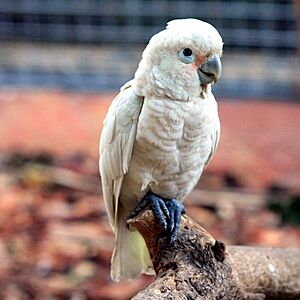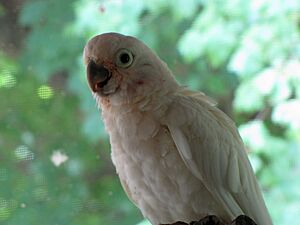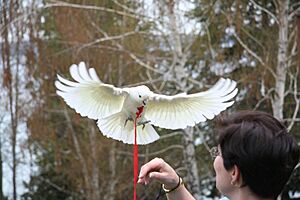Tanimbar corella facts for kids
Quick facts for kids Tanimbar corella |
|
|---|---|
 |
|
| Conservation status | |
| Scientific classification |
The Tanimbar corella (Cacatua goffiniana) is a small, white cockatoo. People also call it Goffin's cockatoo or Tanimbar cockatoo. This bird lives only in the forests of the Tanimbar Islands in Indonesia. These islands include Yamdena, Larat, and Selaru.
Sometimes, these birds have been moved to other places. You might find them in the Kai Islands (Indonesia), Puerto Rico, and Singapore. Scientists officially described this species in 2004. It was found that earlier descriptions were for a different cockatoo. The Tanimbar corella is the smallest of all white cockatoos. Sadly, it is considered "Near Threatened." This means it could become endangered because of trees being cut down and the illegal bird trade. Luckily, these birds can be bred well by people. Many Tanimbar corellas now live outside their natural home.
Contents
About the Tanimbar Corella
Tanimbar corellas are small birds. Females usually weigh about 250 grams (9 ounces). Males are a bit heavier, around 300 grams (11 ounces). From head to tail, they are about 31 centimeters (12 inches) long.
Like all cockatoos, the Tanimbar corella has a special group of feathers on its head. This is called a crest. The bird can raise or lower its crest. Most of its body is covered in white feathers. But it has soft pink or salmon-colored feathers near its beak and eyes. The hidden parts of its crest and neck feathers are also salmon-colored.
The feathers under its wings and tail have a yellowish color. Its beak is light gray. Female birds have brown eyes, while males have black eyes. Males are slightly bigger than females, but they look very similar. In captivity, Tanimbar corellas can live for up to 30 years. This makes them one of the shorter-lived cockatoo types.
Reproduction and Life Cycle
Not much is known about how these birds breed in the wild. We don't know their exact breeding season. We also don't know much about their mating habits. Usually, a female bird lays 2 or 3 eggs at a time.
Most of what we know about their breeding comes from birds raised by people. In the United Kingdom, bird experts say they breed in late spring. The eggs hatch before July. Both parents take turns sitting on the eggs for about 28 days. The mother bird feeds her babies for about three weeks after they learn to fly.
Protecting Tanimbar Corellas
The Tanimbar corella is listed as "Near Threatened" on the IUCN Red List. This means they are close to becoming endangered. Their homes are being destroyed in Tanimbar. Also, their numbers are small, and people illegally hunt them. In the 1970s, loggers cut down many trees on the islands. Many confused birds were caught and sold as pets.
Many birds died during shipping because of stress. But there was a small good side to this problem. Many Tanimbar corellas reproduced in special breeding programs. Because of this, there are now more Tanimbar corellas living with people than in the wild.
Scientific Name Changes
The Tanimbar corella was first described by Otto Finsch in 1863. He named it Lophochroa goffini after his friend, Andreas Leopold Goffin.
However, in 2000, scientists realized that Finsch's description was based on two birds that were actually a different species. Those birds were Solomons cockatoos (Cacatua ducorpsii). So, the name Cacatua goffini became a synonym for Cacatua ducorpsii. This left the Tanimbar corella without a proper scientific name. In 2004, the species was officially named Cacatua goffiniana. This new name still honored Finsch's friend. The new description was based on a bird collected in 1923 from the Tanimbar Islands.
Tanimbar Corellas as Pets
As pets, these parrots are often called Goffin's cockatoos. If they are raised by people from a young age, they can sometimes copy human speech. But they are not usually very good talkers. They are generally quieter than bigger cockatoos. However, they can still be quite loud and have a sharp screech.
Tanimbar corellas learn by watching and copying. For example, they can watch you open their cage door. Then, they can figure out how to open the latch with their beak in seconds. These birds can also chew on furniture and wires. This can cause damage or even dangerous electrical problems.
Pet Tanimbar corellas need a lot of attention. If they don't have interesting things to do, they might start pulling out their own feathers. They might also do the same movements over and over. They need new toys often so they don't get bored. They also need to spend at least four hours a day outside their cage. This lets them socialize and exercise their wings. Even very friendly birds can bite if they are annoyed or playing too roughly. Their droppings can be messy. The World Parrot Trust suggests that these birds need a cage at least 3 meters (10 feet) long. Many new bird owners don't realize how much time and money a cockatoo needs. Because of this, pet birds are often passed to new owners or given to animal shelters.
Baby Tanimbar corellas make a soft, howling or screeching noise when they are hungry. In the UK, selling these birds is controlled. This is because they are a rare species. Sellers must have a certificate to prove the bird was bred by people and not caught from the wild.
Amazing Intelligence
Studies show that the Tanimbar corella is very smart. They have been seen using tools when living with people. In 2012, a scientist named Professor Alice Auersperg saw a male cockatoo named Figaro. He made splinters of wood and small sticks into "rakes." He used these tools to reach food that was too far away.
In 2013, scientists found that these birds could solve complicated problems. One bird figured out how to open a lock with five parts in the correct order to get food. The corellas quickly changed how they opened the lock if parts were moved. This showed they understood how things work, not just repeating actions. In 2022, a study showed they could use a stick to hit a marble into a hole. This released a cashew nut reward. Figaro, the same bird, even found a way to cheat! He used his stick to lift the test machine and get the cashew.
Another experiment looked at whether the birds could control themselves. This was like the famous "marshmallow test" for kids. The corellas could trade a less favorite nut (pecan) for a more favorite one (cashew). They had to hold the pecan without eating it for a short time. Even though they usually ate pecans right away, they could wait up to 80 seconds for the cashew. This showed that birds can have self-control.
More research in 2018 showed that corellas could cut cardboard with their beaks to make tools. They could change the length of the tools. But they seemed unable to change the width, probably because of their beaks.
In 2020, scientists compared pet corellas with wild ones. They gave them 20 different tasks to get food. Wild birds were less likely to try the tasks. But those that did solved them just as well as the pet birds. Wild corellas were also seen shaping sticks to eat sea mango seeds.
A 2020 study even suggested that Tanimbar corellas might be able to read! A female bird named Ellie learned to connect written words with pictures. She also connected spoken words with pictures. She was 94% accurate. This showed she could process words and understand their meaning. Ellie also learned to use a tablet computer to talk to researchers. She touched symbols on the screen to ask for food, drinks, or to play.





